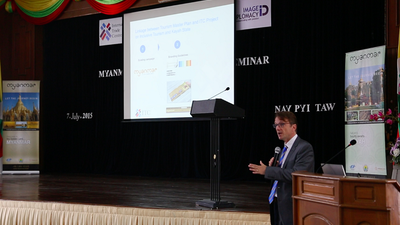The Big Picture: Tourism and Sustainable Development
As a US$ 3 billion a day global business, the tourism sector is one of the world’s fastest growing industries and an important driver for economic growth in least developed countries.
Since the 1950s, tourism has experienced continued expansion and diversification, becoming one of the largest and fastest growing economic sectors in the world. As an export category, tourism currently ranks fourth globally after fuels, chemicals and automotive products. For as many as 23 of the 49 least developed countries (LDCs), international tourism is among the top three foreign exchange earners, accounting for up to 40% of each country’s GDP.
According to figures by the World Trade Organization (WTO) and UN Conference on Trade and Development (UNCTAD), the development of tourism has been identified as an important factor for at least 10 LDCs that will reach WTO graduation (the economic advancement of developing countries through industrialization, export development and rising living standards) thresholds over the next decade. Tourism has also been singled out as a distinct ‘graduation factor’ for at least three former LDCs, notably Cape Verde, the Maldives and Samoa. Growth supported by the development of tourism can also occur at an impressive pace, as has been the case in countries like Tanzania and Costa Rica.
‘This is a sector that from an export perspective is a relatively new activity for LDCs. Despite this, the development dimension of tourism is increasingly recognized as central to their economic recovery and long-term growth. Between 2000 and 2009, receipts from international tourism in LDCs grew by more than 14% annually, higher than the growth rate of 10% for other developing economies and double the global average of 7%,’ said WTO Director-General Mr. Pascal Lamy in his opening address at the World Export Development Forum (WEDF) in May.
Despite having been hard-hit by the recent economic and financial crisis, the tourism sector continues to be among the most dynamic in the global economy. The worldwide contribution of tourism to GDP exceeds 5% and its annual turnover has been growing at a faster pace than GDP.
According to the World Tourism Organization (UNWTO), demand for tourism services fell abruptly in mid-2008 but returned to growth in the last quarter of 2009 and continued to grow throughout 2010 and into the first quarter of 2011. In 2010 international tourism receipts surpassed US$ 900 billion, up 4.7% on 2009. According to the April interim update of the UNWTO World Tourism Barometer Worldwide, international tourist arrivals surpassed 124 million in the first two months of 2011, up from 119 million for the same period in 2010, with emerging economies continuing to grow at a faster pace (+6%) than developed countries (+4%).
‘These results confirm that in spite of several challenges, the recovery of international tourism, which was remarkably strong last year, is consolidating,’ said UNWTO Secretary-General Mr. Taleb Rifai in his address at WEDF 2011.
‘News is especially positive for emerging economies and developing countries, particularly for Africa where tourism is increasingly recognized as a driver of development, exports and jobs,’ he added.
In part, this recovery can be credited to measures – be they fiscal, monetary or marketing support to the tourism sector – that many countries implemented to stimulate their economies and restore growth after the crisis.
Strong tourism growth in 2010
According to UNWTO Tourism Highlights (2011 edition), the vast majority of destinations reported positive increases on 2009 figures in international tourist arrivals during 2010. All regions posted positive growth in real terms, with the exception of Europe (-0.4%). The Middle East (+14%) and Asia and the Pacific (+13%) showed the strongest growth, while the Americas (+5%) was close to the worldwide average and Africa grew (+3%) somewhat slower, despite strong growth in South Africa (+15%) after the hosting of the football World Cup. The most significant change in 2010 international arrivals was the emergence of China to third place in international arrival numbers and fourth place in terms of tourism receipts (+15%) (Figure: Growth in International Tourist Arrivals 2010).
Emerging tourism trends favour LDCs
Special interest segments such as adventure, cultural and nature-based tourism are penetrating traditional tourism markets. According to Mr. Christopher Brown, Co-Chairman of the World Tourism Organization’s Business Council, many LDCs are perfectly positioned to take advantage of these emerging tourism trends, especially growth in ecotourism and increasing demand for authentic, off-the-beaten-track, cultural experiences that lend themselves well to emerging economies.
Defining ecotourism as ‘responsible travel to natural areas which conserves the environ-ment and sustains the well-being of local people,’ The International Ecotourism Society (TIES) reports that since 2004, ecotourism has become the fastest growing sector of the tourism industry and has been growing at a rate three times faster than traditional tourism. TIES also predicts that sustainable tourism could grow to 25% of the global travel market by 2012.
According to TIES Global Ecotourism Fact Sheet (September 2006), the economics of ecotourism outweigh those of mass tourism. The report states that 80% of money for all-inclusive package tours goes to airlines, hotels and other international companies, compared to ecolodges that tend to hire and purchase locally, and sometimes put as much as 95% of earnings back into the local economy. Daily expenditure by cultural tourists (over US$ 90) is higher than visitors on a touring holiday (US$ 67), beach holiday (US$ 62), city break (US$ 54) or rural trip.
‘The high-yield, low-impact ecotourism sector is perfectly suited to LDCs because they don’t have the infrastructure required to manage mass-market tourism. But usually one of the great advantages of LDCs is that the lack of development means there is still a natural environment,’ said Mr. Brown.
Citing the example of Costa Rica’s tourism industry in previous years, Mr. Brown highlighted that the country’s success was largely built on the development of its ecotourism offering. However, he also alluded to the fact that part of the destination’s relatively fast emergence was a result of the country becoming politically stable enough to be considered an exotic Central American destination to the northern market and its focus on managing the environmental impact of tourism through its national ecotourism certification programme.
The future for tourism-led growth and inclusive sustainable development in LDCs
A focus on managing the environmental impacts of tourism was one of the issues raised in discussions at WEDF 2011. Pressures on land use as well as waste generation can become significant problems for some LDCs, especially for remote island communities. This is also true for the high levels of water and energy use for which the tourism industry is known. Such use may exceed local sustainable limits and displace other economic and social uses of limited water and energy supplies.
In his address at WEDF, UNCTAD Secretary-General Dr. Supachai Panitchpakdi called for ‘strong regulatory and government support’ which will be ‘required to ensure tourism develops in a sustainable manner, consistent with local needs.’
He also warned that while tourism offers many opportunities for income and employment generation in local communities, particularly through links to the local economy with sectors supplying services consumed by tourists (such as retail, recreational, cultural, ground transport, agriculture and handicrafts) policymakers need to pay careful attention to increasing the pro-poor impacts of tourism expenditures for maximum development impact to be achieved.
WORLD TOURISM at a glance
• Tourism is a US$ 3 billion a day global business, accounting for US$ 1 trillion in global export income in 2010.*
• Tourism’s contribution to worldwide gross domestic product (GDP) is estimated at 5%.*
• Tourism exports account for as much as 30% of the world’s exports of commercial services and 6% of overall exports of goods and services.*
• International tourism receipts surpassed US$ 900 billion in 2010.#
• Tourism’s contribution to employment is estimated to be in the order of 6-7% of the overall number
of jobs worldwide (direct and indirect).*
• International tourism is among the top three foreign exchange earners for as many as
23 of the 49 least developed countries.*
• Worldwide international tourist arrivals surpassed 124 million in the first two months of 2011,
up from 119 million in the same period in 2010.
• Tourism arrivals are growing at a faster pace in emerging economies (+8%) than in advanced ones (+5%).*
• International arrivals are expected to reach
nearly 1.6 billion by 2020, with 1.2 billion arrivals expected to be intraregional and 400 million long‑haul travellers.^
Source:
* UNWTO, Tourism Highlights (2011 Edition)
# UNWTO, World Tourism Barometer, April 2011 Interim Update
^ UNWTO, Tourism 2020 Vision
Spotlight on ecotourism in Costa Rica
With a million tourist arrivals annually, tourism in Costa Rica is a US$ 1.92 billion a year industry and the country’s second largest source of income, accounting for 7.8% of GDP in direct terms and nearly 3% of total employment (in 2008) according to data from UNWTO. Taking advantage of its incredible biodiversity, with 32 national parks, eight biological reserves, 13 forest reserves and 51 wildlife refuges, along with scenic beaches, lush rainforests, volcanoes and exotic wildlife, Costa Rica has focused on the development of ecotourism as the key to its economic development.
Previously dependent on agriculture for 65% of its exports, ecotourism has helped diversify Costa Rica’s national economy. It is now one of the world’s leading ecotourism destinations and has been praised for its attention to conservation through the implementation of the Certification for Sustainable Tourism programme developed by the Costa Rican Tourism Board and regulated by the Costa Rican National Accreditation Commission. The certification programme was designed to differentiate tourism companies based on the ‘degree to which they comply with a sustainable model of natural, cultural and social resource management’ according to the Certification for Sustainable Tourism.
Spotlight on Tanzania
In the United Republic of Tanzania, tourism is the country’s top export earner, outperforming other services categories and accounting for over 35% of total goods and services exports. The success is largely attributed to the liberalization of the tourism sector in the 1990s, which revitalized an industry that accounted for less than 10% of total export earnings in the mid-1980s. Tanzania’s pro-poor tourism success story is largely attributed to its strategy of maintaining a high-value tourist product through packaged tourism products (e.g. climbing Mount Kilimanjaro and the northern safari circuit) to attract large numbers of foreign tourists. Unlike many LDCs where profits repatriated to foreign investors mean that the host country receives only a small portion of revenues, Tanzania is capturing about half of the total value of the global value chain for packaged holidays sold overseas – a reasonable proportion given the cost of long-haul flights. A 2009 Overseas Development Institute/SNV report, Making success work for the poor: Package tourism in Northern Tanzania, suggests that poor Tanzanians are capturing a relatively large share of tourist spending, with approximately 20-30% reaching poor people at the destination.
For a copy of the full report visit www.odi.org.uk/resources/download/3221.pdf







